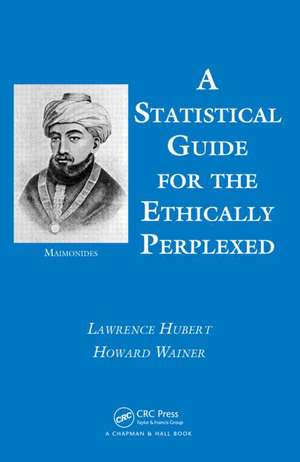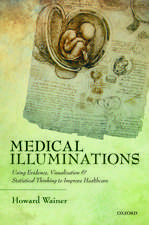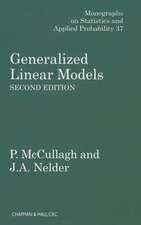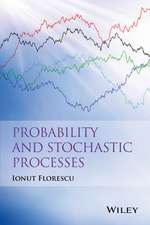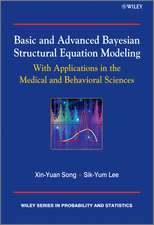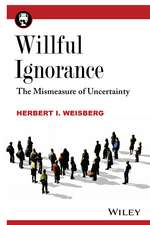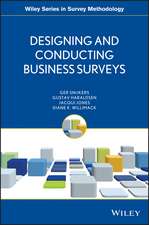A Statistical Guide for the Ethically Perplexed
Autor Lawrence Huberten Limba Engleză Paperback – 25 sep 2012
Preț: 504.66 lei
Nou
Puncte Express: 757
Preț estimativ în valută:
96.58€ • 104.87$ • 81.13£
96.58€ • 104.87$ • 81.13£
Carte tipărită la comandă
Livrare economică 22 aprilie-06 mai
Preluare comenzi: 021 569.72.76
Specificații
ISBN-13: 9781439873687
ISBN-10: 1439873682
Pagini: 592
Ilustrații: 7 black & white illustrations, 14 black & white tables
Dimensiuni: 156 x 234 x 33 mm
Greutate: 0.82 kg
Ediția:New.
Editura: CRC Press
Colecția Chapman and Hall/CRC
ISBN-10: 1439873682
Pagini: 592
Ilustrații: 7 black & white illustrations, 14 black & white tables
Dimensiuni: 156 x 234 x 33 mm
Greutate: 0.82 kg
Ediția:New.
Editura: CRC Press
Colecția Chapman and Hall/CRC
Public țintă
Professional Practice & DevelopmentCuprins
Tools from Probability and Statistics. Data Presentation and Interpretation. Experimental Design and the Collection of Data. Bibliography. Indices.
Notă biografică
Lawrence Hubert is the Lyle H. Lanier Professor of Psychology and a professor of statistics and educational psychology at the University of Illinois. He is a fellow of the American Statistical Association, American Psychological Association, Association for Psychological Science, American Association for the Advancement of Science, and American Educational Research Association. Dr. Hubert has been a recipient of honors, including the Jacob Cohen Award for Distinguished Contributions to Teaching and Mentoring from Division 5 of the American Psychological Association. His research focuses on the development of exploratory methods for data representation in the behavioral sciences, emphasizing cluster analysis, spatially oriented multidimensional scaling techniques, and network representation procedures.
Howard Wainer is a Distinguished Research Scientist at the National Board of Medical Examiners and adjunct professor of statistics at the Wharton School of the University of Pennsylvania. He is a fellow of the American Statistical Association and American Educational Research Association. Dr. Wainer has been a recipient of several honors, including the Samuel J. Messick Award for Distinguished Scientific Contributions Award from Division 5 of the American Psychological Association and the Career Achievement Award from the National Council on Measurement in Education. His research encompasses the use of graphical methods for data analysis and communication, robust statistical methodology, and the development and application of generalizations of item response theory.
Howard Wainer is a Distinguished Research Scientist at the National Board of Medical Examiners and adjunct professor of statistics at the Wharton School of the University of Pennsylvania. He is a fellow of the American Statistical Association and American Educational Research Association. Dr. Wainer has been a recipient of several honors, including the Samuel J. Messick Award for Distinguished Scientific Contributions Award from Division 5 of the American Psychological Association and the Career Achievement Award from the National Council on Measurement in Education. His research encompasses the use of graphical methods for data analysis and communication, robust statistical methodology, and the development and application of generalizations of item response theory.
Recenzii
"This text draws attention to a topic that often seems to be neglected or at least carelessly regarded: the intersection of statistics and ethics. … this text represents Hubert and Wainer’s attempt to balance statistics and standards of ethical practice. The authors achieve this by providing interesting and relevant real-life examples covering a variety of topics … this book stands out as a unique text that combines a review of mathematical theorems and formulas, guidance on how to be sharp when using or interpreting statistics, and the impacts (often negative) that can happen (and have happened) when analyses are conducted carelessly. All of these components come together effectively to raise the reader’s awareness of ethics in creating and interpreting statistics, and ultimately help the reader become a more astute and ethically responsible analyst."
—Journal of Official Statistics, Vol. 30, No. 3, 2014
"… a one-of-a-kind volume. … In 18 pithy chapters, this paperback edition covers some of the most important issues of correct reasoning to reach correct conclusions. … a lot of well written information. … Do you really need another book, this book, on research and statistics? YES!"
—Malcolm James Ree, Personnel Psychology, Spring 2014
"… a fascinating and at times perplexing read … I learned some surprising things from reading it …"
—Paul T. Seed, Significance, April 2014
"… most should find it of great use as a guide to the literature on aspects of our discipline that we may lack a formal background in. This is especially so if we are most familiar with the application of statistics to the natural sciences rather than the human sciences. I think that a teacher of senior courses in applied statistics would find a use for this book in helping put some real-world flesh on the theoretical bones of the course. It would also be a useful source of readings (or lead to the discovery of readings) for handouts."
—Murray Jorgensen, Australian & New Zealand Journal of Statistics, 2013
"… even the most experienced statisticians will find the extensive quoted extracts and discussions entertaining, informative, and illuminating. … The volume will provide a great source of illustrative material to enliven courses teaching the ideas and methods behind the topics discussed within it. More than that, however, a course, or perhaps a reading group, based around this book would complement the necessarily dryer material describing the ideas and structures of statistical methods. It would drive home the vital importance of statistics to modern society and certainly make the students sit up and take notice.
In short, the authors are to be congratulated on producing a wonderful volume. I believe that all students of statistics, perhaps of science more generally, would benefit substantially from reading it (and then re-reading it when they had a few years’ practical experience under their belts)."
—David J. Hand, International Statistical Review (2013), 81, 2
"… valuable as a reference … . There is a 40-page bibliography, a six-page author index, a 14-page subject index, and a 13-page list of sources, plus a 105 page online supplement that consists mostly of legal decisions and recommended reading. Using all the resources provided, one can assemble a very long list of issues and applications, with readings and references. … recommended … a resource the statistically sophisticated teacher can mine for material from which to create their own examples to engage students."
—Robert W. Hayden, MAA Review, December 2012
"This thorough and readable work covers important topics spanning specific and general causation to experimental design. It offers engaging examples, lucid explanations, and a thorough consideration of truly important issues, giving readers the knowledge to deal more effectively with ethically charged situations. A valuable guide for sorting through ethical issues in the behavioral, social, and biomedical sciences."
—C.K. Gunsalus, Director, National Center for Professional and Research Ethics, and Research Professor, Coordinated Science Laboratory, University of Illinois at Urbana-Champaign
—Journal of Official Statistics, Vol. 30, No. 3, 2014
"… a one-of-a-kind volume. … In 18 pithy chapters, this paperback edition covers some of the most important issues of correct reasoning to reach correct conclusions. … a lot of well written information. … Do you really need another book, this book, on research and statistics? YES!"
—Malcolm James Ree, Personnel Psychology, Spring 2014
"… a fascinating and at times perplexing read … I learned some surprising things from reading it …"
—Paul T. Seed, Significance, April 2014
"… most should find it of great use as a guide to the literature on aspects of our discipline that we may lack a formal background in. This is especially so if we are most familiar with the application of statistics to the natural sciences rather than the human sciences. I think that a teacher of senior courses in applied statistics would find a use for this book in helping put some real-world flesh on the theoretical bones of the course. It would also be a useful source of readings (or lead to the discovery of readings) for handouts."
—Murray Jorgensen, Australian & New Zealand Journal of Statistics, 2013
"… even the most experienced statisticians will find the extensive quoted extracts and discussions entertaining, informative, and illuminating. … The volume will provide a great source of illustrative material to enliven courses teaching the ideas and methods behind the topics discussed within it. More than that, however, a course, or perhaps a reading group, based around this book would complement the necessarily dryer material describing the ideas and structures of statistical methods. It would drive home the vital importance of statistics to modern society and certainly make the students sit up and take notice.
In short, the authors are to be congratulated on producing a wonderful volume. I believe that all students of statistics, perhaps of science more generally, would benefit substantially from reading it (and then re-reading it when they had a few years’ practical experience under their belts)."
—David J. Hand, International Statistical Review (2013), 81, 2
"… valuable as a reference … . There is a 40-page bibliography, a six-page author index, a 14-page subject index, and a 13-page list of sources, plus a 105 page online supplement that consists mostly of legal decisions and recommended reading. Using all the resources provided, one can assemble a very long list of issues and applications, with readings and references. … recommended … a resource the statistically sophisticated teacher can mine for material from which to create their own examples to engage students."
—Robert W. Hayden, MAA Review, December 2012
"This thorough and readable work covers important topics spanning specific and general causation to experimental design. It offers engaging examples, lucid explanations, and a thorough consideration of truly important issues, giving readers the knowledge to deal more effectively with ethically charged situations. A valuable guide for sorting through ethical issues in the behavioral, social, and biomedical sciences."
—C.K. Gunsalus, Director, National Center for Professional and Research Ethics, and Research Professor, Coordinated Science Laboratory, University of Illinois at Urbana-Champaign
Descriere
Exploring the intersection of ethics and statistics, this guide illustrates the use of probabilistic and statistical reasoning in the sciences. Seven U.S. Supreme Court decisions reflect the influence of statistical and psychometric reasoning and interpretation/misinterpretation.
